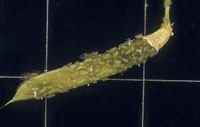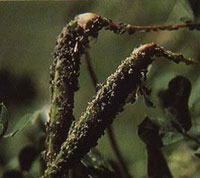Acyrthosiphon caraganae
Host
Caragana
Appearance and Life Cycle

Photo credit: AAFC-Agroforestry Development Centre
Caragana aphids emerge as nymphs from overwintering eggs in May and June. The aphids are soft-bodied, pear-shaped, approximately 2 mm in length and are light green to green in colour. Caragana aphids, except for the last generation, are females that are able to reproduce without mating and give birth to live young. First generation adults are wingless, whereas later generations may have a partial population of winged adults.
When the host plant becomes overcrowded, the winged forms migrate to other plants. The caragana aphid is capable of completing 20 generations per year with each adult giving birth to 20-25 nymphs. By late September, parasites, predators and the maturing of the host plant causes a decline in the aphid population and only small isolated colonies may be found. At this time, male and female aphids are produced. Both nymphs and adult males are easily recognized bytheir reddish colour, compared to the greenish colour of other forms. After mating, the females deposit their overwintering eggs in bark crevices on the host plant.
Damage

Photo credit: University of Nebraska-Lincoln, unl.edu
The nymphs and adults of the caragana aphid feed in colonies on the leaves, twigs and seed pods of caragana. The aphids cause damage by piercing the plant with their mouth parts and sucking the sap. The leaves wilt, and in severe cases drop prematurely. During a heavy infestation entire shelterbelts have been completely defoliated, reducing annual growth. The following year the shrubs will refoliate as usual.
Control
The caragana aphid can be controlled by one of the following insecticides: diazinon; dimethoate; malathion or permethrin. Before applying an insecticide, check for beneficial predators, such as ladybugs and birds, and remember that aphid populations are severely reduced by late summer.